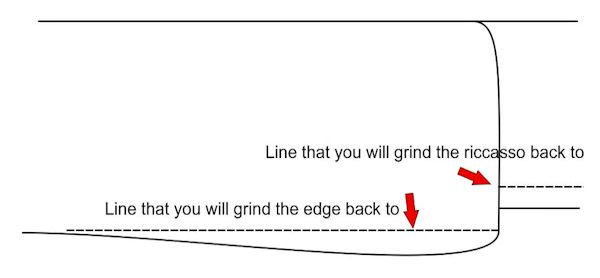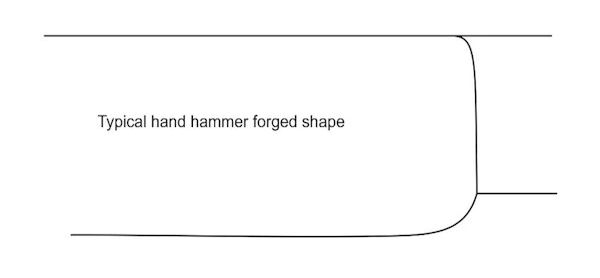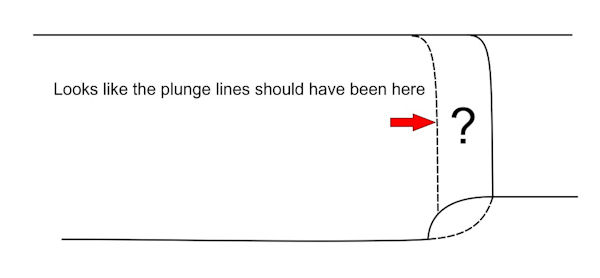Hi, have noticed many blades I see, particularly bowies with deep bellies have an almost 90deg transition from the ricasso to down to the edge. I'm not sure if I'm describing this quite right, but the steel for the edge is drawn almost straight down. I have just finished forging a bowie today, and was unable to get it and straighter then a circular shape. My question is how to get it to draw out straigher? Are people using power hammers?,flatters? ,grinding it? ,or do I just need more practise.
Personally I prefer the asthetic of the sharp 90deg transition but does it look off to leave it a more rounded shape? I also occasionally see the opposite with the rounded shape but cut out into the blade. Any thought on the asthetics of this style? Hopefully I am describing this right, and everyone understands what I am talking about. Thanks for any advice on the matter, Justin
A power hammer certainly helps to push the steel down to create a straighter drop from the riccasso to the edge. It can be done with a hand hammer, but is much more difficult.
Typically, when you see this 90 degree drop from the riccasso to the edge, it is because the smith used bar stock that is wider than he intends for the riccasso to be in the finished blade. When forging from wide bar stock, there will be excess material at the edge that will be pushed beyond where the edge is intended to be. This material can be cut, or ground back during the forging process, so the edge can be forged close to the final thickness. The bottom of the riccasso will be ground back to the final dimensions during the grinding of the blade.
There is nothing wrong with the appearance of a hand forged blade where the material makes a radius from the edge to the bottom of the riccasso. You want to push as much material back into this radius as possible, but it is understood how you forged this blade.
It used to be common to see blades where the maker ground away the radius to create a straight drop to the edge. This is basically out of fashion now. The reason is because it creates the appearance that the maker was chasing his plunge lines. It looks as though the plunge lines should have been closer to the point where the edge begins, but the maker had trouble grinding the plunge lines and chased them back too far.
Thank you for your help Steve. I will stop worrying about it, at least until I get a power hammer, or some wider stock. -Justin
|quoted:
A power hammer certainly helps to push the steel down to create a straighter drop from the riccasso to the edge. It can be done with a hand hammer, but is much more difficult.
Typically, when you see this 90 degree drop from the riccasso to the edge, it is because the smith used bar stock that is wider than he intends for the riccasso to be in the finished blade. When forging from wide bar stock, there will be excess material at the edge that will be pushed beyond where the edge is intended to be. This material can be cut, or ground back during the forging process, so the edge can be forged close to the final thickness. The bottom of the riccasso will be ground back to the final dimensions during the grinding of the blade.
There is nothing wrong with the appearance of a hand forged blade where the material makes a radius from the edge to the bottom of the riccasso. You want to push as much material back into this radius as possible, but it is understood how you forged this blade.
It used to be common to see blades where the maker ground away the radius to create a straight drop to the edge. This is basically out of fashion now. The reason is because it creates the appearance that the maker was chasing his plunge lines. It looks as though the plunge lines should have been closer to the point where the edge begins, but the maker had trouble grinding the plunge lines and chased them back too far.
Steve,
rather than grind the steel on the tang, could you not forge it back into the tang to make a narrower but thicker tang?
Cheyenne Walker
Apprentice Smith
Cheyenne,
This could certainly all be done by forging. As with all blade forging, it depends on what you want the final result to be. Forging the 90 degree transition could be done with some special tooling and a bit of smithing skill. Sometimes it is just more expedient to grind a little material to create the shape that you want. I chose to describe the most simplistic method of creating this configuration to make it easier to understand.
ok, thanks Steve. <img src=' http://www.americanbladesmith.com/ipboard/public/style_emoticons//smile.gi f' class='bbc_emoticon' alt=':)' />
Cheyenne Walker
Apprentice Smith
Just my two cents worth, but I prefer the rounded transition shown in Steve's second diagram. The reason is that if you stick the blade into something all the way up to the riccasso, the sharp corner will make it more difficult to withdraw the blade than the rounded one.
Dale
Dale Huckabee
Journeyman Smith
dalehuckabeeknives.weebly.com
If you grind in that 90 degree transition area make sure not to leave any deep scratches especially when doing an edge quench.
Some time back I had a very nice looking blade crack during the quench starting in that area. Upon close inspection there was some rough grind lines that I missed in that area and one of those lines/scratches was the fatal stress riser. Help me out if anyone has had this happen in the past.
Speaking of stress risers, I have seen some makers,even mastersmiths, when grinding, square off their tang on the top and bottom, where it meets the back of the ricasso. I was taught to have a little radius in this location to avoid stress risers. When you make the slot in the guard, you can file the top and bottom to accomodate to for this. Am I right? Thanks-Bill Kirkes




